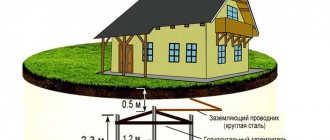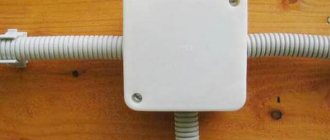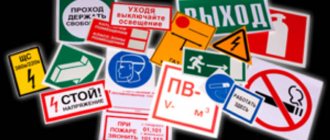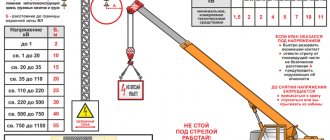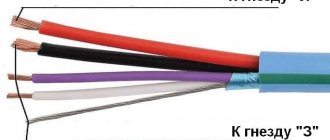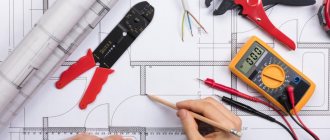Instructions for labor protection when performing electrical installation work in existing electrical installations
Local regulations of a manufacturing enterprise are valid on the territory of the organization itself and apply either to all employees or to a certain group of officials to whom they are addressed. One of the most important acts in the company is the instruction on labor protection for electricians or other specialties who are directly involved in this type of work. State acts to ensure the safety of employees during activities related to electricity pay special attention, regardless of the typical profession, be it an auto electrician, a high-altitude worker, an electrician, an electrician of electrical equipment, a network electrician, or a premises repair electrician.
Basic safety when handling electrical installations during the work process
As a rule, all these professions are directly related to the negative impact of electric current and in order to minimize the possibility of negative consequences, it is imperative to create a special internal document and comply with special regulations, which are safety precautions when performing electrical installation work. Such a document contains a list of requirements for behavior, as well as sections on the safety of labor activities in the field of legal relations.
Important! In addition, during inspection actions by government agencies, it is mandatory to check the presence of such instructions and the procedure for implementing its instructions. If violations are detected against officials, administrative violation protocols are drawn up.
A stand describing the necessary measures to ensure the safety of the labor process
General safety requirements
The general provisions of the document contain standard requirements and take into account the specifics of the organization in this area. According to these rules, the working day procedure, the use of certain protective equipment, the status of the employee himself, the receipt of equipment during the work process, new legislation on labor protection, as well as the procedure for setting up and servicing entrusted equipment are determined.
Safety requirements before starting work
Before starting any work involving exposure to electric current, the employee must be briefed on safety precautions at work. Instruction is especially important when carrying out adjustment and commissioning types of work that are associated with new or repaired equipment. After carrying out such activities, the worker puts a special mark in the logbook.
Basic requirements for a worker when working with electricity
Safety requirements during operation
During work activities, the employee is obliged to comply with instructions and labor safety rules, be sure to use all protective equipment and avoid emergency situations. He must also be guided by the orders of management for carrying out routine maintenance.
Safety requirements in emergency situations
In the event of an emergency, the worker is obliged to report this fact to the work supervisor, use primary protective equipment to minimize the consequences of the accident, provide assistance to the injured, or, in a certain situation, leave the work site through special emergency exits.
Typical protective equipment when working with live installations
Safety requirements upon completion of work
At the end of their work, the working personnel must notify management of its completion and hand over the used protective equipment, as well as insulation equipment, for signature, and note it in the work log.
Electric installation work
- Work with voltages up to 1000 V should be carried out with tools with securely insulated handles. Insulation should be carried out in the form of a cover and a permanent coating based on moisture-, oil-, petrol-resistant and electrical insulating material. According to existing rules, the length of the handle insulation must be at least 100 mm, and the insulation of screwdrivers ends at a distance of no more than 10 mm from the end of the blade.
- Before starting to work with a power tool, you should make sure that: punching holes and grooves in walls, ceilings with electrical wiring, performing other work that could damage the insulating coating of cables (installing the same water pipes) is possible only after disconnecting them from the power source.
- All screws and fastening parts must be well tightened;
- The gearbox must be in good working order (first turn off the electric motor and turn the spindle by hand);
- The insulation and wires of the power tool must not be damaged or broken wires;
- Grounding and switches must be in good working order (tools with secondary insulation do not require grounding).
- The use of defective power tools is prohibited.
If you use a soldering iron during work, make sure that it is always in the working area of the hood in its working condition. It is impossible to shake off the remaining solder when soldering, and its excess is removed on a special stand. During breaks, the electric soldering iron is placed on a special stand with metal brackets. It is prohibited to eat (eat) in the room or premises where soldering is taking place.
When carrying out electrical installation work, soldering irons are used that are powered by alternating current and a voltage of no more than 42 V. Constant use of 220 V electric soldering irons is allowed if they are powered from an isolation transformer/through a disconnect device.
Precautions are taken when testing installed equipment
- The first test switching is carried out in the absence of people near the live parts of the installation;
- Also, test switching is carried out after checking the compliance of all installation diagrams with project documentation and contact connections in the circuit elements.
- During work, it is necessary to strictly follow the safety rules. This will help avoid serious injuries that an inexperienced technician could receive.
- If a serious breakdown suddenly occurs, then it is necessary to call an electrician who has knowledge of repairing electrical installations. An electrician must know safety precautions.
- You can carry out minor repair work on a switch, socket or cable yourself. You don't need any special knowledge or skills for this. At the same time, it is worth remembering the main rule: before starting repairs, be sure to turn off all electricity in the house.
- It is important to remember that the human body has little resistance, so it is an excellent conductor of electric current. Also, water is a good conductor of current. If you touch water while working with electrical appliances, namely a bare wire, you will receive an electric shock, which can cause paralysis of the heart and breathing, and as a result, death.
Occupational safety training program for electrician
Safety precautions during welding work
Institutions related to electricity have a special training program for standards and requirements in the field of labor protection. Such training is carried out for all citizens involved in such work by a responsible official who is vested with the powers of a labor protection specialist. This program contains the main provisions in the field of ensuring safe work activities, as well as ways to implement a safe work process.
OCCUPATIONAL SAFETY REQUIREMENTS DURING WORK
3.1. An employee who is ill or overtired, as well as under the influence of alcohol, drugs or medications that dull attention and reaction, should not start work, as this may lead to an accident. 3.2. During work, you need to behave calmly and with restraint, avoid conflict situations that can cause nervous and emotional tension and affect work safety. 3.3. While working, you should be careful and not be distracted from your duties. 3.4. When performing electrical installation work, the following safety requirements must be met: - it is not allowed to perform work at height, as well as when using electrical equipment, electrical measuring instruments during rain, thunderstorms and wind speeds of more than 12 m/s; — drilling and punching holes in brick and concrete, pulling steel wire into pipes must be done using safety glasses with safety glasses; — when punching holes with a hand tool (jumper, mandrel, etc.), it is necessary to check that the length of its working part exceeds the wall thickness by at least 200 mm; — when pulling a wire (cable) into a pipe (channel), the worker’s hands must be at least 1 m from the end of the pipe (channel); — when measuring the insulation resistance of wires and cables with a megohmmeter, the ends of the wires (cables) on the opposite side must be fenced or under the control of a person on duty specially designated for this purpose, certified according to electrical safety rules; — electrical installation personnel are prohibited from performing any work related to the operation of electrical installations; — when using lifting machines and slinging materials, products and structures, electricians must have a slinger (rigger) certificate. 3.5. When installing power and lighting networks, the following safety requirements must be met: - pipes and metal structures should be placed on the ground or floor on pads; — the ends of the pipes must be filed and cleaned of burrs; — before installing group panels and devices, you need to check the reliability of their assembly and procurement units and assemblies; — checking the coincidence of holes in the structures being connected should be carried out using special mounting devices; — installation of lighting fixtures weighing more than 10 kg should be carried out by two people; — busbar trunking should be installed sectionally or one block at a time; accumulation of sections or blocks on scaffolding, overpasses and service bridges is prohibited. 3.6. When installing distribution devices, the following safety requirements must be met: - lifting, moving and installing disconnectors and other cutting-type devices must be in the “On” position, and devices equipped with return springs or free distributor mechanisms must be in the “Off” position; — when adjusting switches and disconnectors connected to drives, it is necessary to take measures to prevent their spontaneous activation or deactivation; — checking the simultaneous activation of oil switch contacts should be performed at a voltage not higher than 12 V; — when working on current transformers, their secondary windings must be short-circuited directly to the transformer terminals and grounded until the installation of the circuits connected to them is complete; — when moving the transformer using a lifting machine, the slings must be hooked onto specially provided lifting hooks (eyebolts); — when installing power transformers, their terminals must be short-circuited and grounded for the entire duration of installation work. 3.7. When installing secondary circuits, the following safety requirements must be observed: - the worker should make sure that the clamp assemblies installed in the switchgear chambers are covered with casings and equipped with warning signs indicating the voltage; — bending the cores of copper and aluminum wires and the cores of control cables into a ring should be done with round pliers or special mechanisms and devices; the use of pliers is prohibited; — an electric soldering iron for soldering wires and cores (to prevent flux and soot from getting on the surface of the table and wires) should be used on a metal stand with a tray; — when soldering small parts and ends of wires, you need to hold them with tweezers or pliers; — it is prohibited to wash soldering areas with gasoline and other flammable liquids; — the crucible for tinning wires must be installed in a stable position in a metal pan with a side. 3.8. Work on the preparation of painting compositions should be carried out in a special room equipped with ventilation. 3.9. In the process of preparing working solutions of paints and varnishes, it is necessary to follow the technological instructions. 3.10. To avoid spontaneous combustion, do not mix polyester varnishes and their components with nitrocellulose varnishes. 3.11. When working with an initiator for polyester varnishes, do not allow it to come into contact with chemicals or allow contaminants to enter it. 3.12. It is not allowed to prepare working solutions of polyester varnishes in the same room as nitro varnishes. 3.13. Solvent can only be transferred from barrels into cans, buckets and other containers using pumps. 3.14. It is necessary for two workers to drain the remaining varnish or solvent from the barrels at a specially equipped area. 3.15. When pouring and draining paints and varnishes, you should use closed-type safety glasses. 3.16. During work, it is necessary to ensure that tanks and cans with paint and varnish materials are tightly closed. 3.17. You cannot accumulate empty barrels and cans of paints and varnishes and solvents near the workplace; they should be taken out in a timely manner to specially designated areas. 3.18. Solvent must not be disposed of down the drain. 3.19. Unauthorized persons are not allowed in the room for preparing painting solutions. 3.20. When performing work on the preparation and application of paint compositions, including imported ones, it is necessary to comply with the safety requirements set out in the manufacturers' instructions. 3.21. You should not work with painting compounds from foreign companies unless their toxicological characteristics and safety measures for their use are known. 3.22. The use of paints and varnishes containing benzene, pyrobenzene, chlorinated hydrocarbons and methanol is not allowed. 3.23. It is not allowed to use paints and varnishes containing more than 15% toluene, xylene and solvent in the working composition. 3.24. The working container should be filled with solutions of paints and varnishes to ¾ of its volume. 3.25. The working container for painting work arriving at the construction site should not exceed 15 kg. 3.26. Paints and varnishes should only be used for the purposes for which they are intended. 3.27. Paintwork and other finishing materials that emit explosive or harmful substances are allowed to be stored at the workplace in quantities not exceeding shift requirements. 3.28. In places where paint compositions that generate explosive vapors are used, electrical equipment must be de-energized or explosion-proof; Work involving the use of fire is not permitted in such places. 3.29. During work, direct contact of the employee with harmful components of the coloring composition must be excluded. 3.30. Staying in a room freshly painted with oil or nitro paints for more than 4 hours is prohibited. 3.31. To avoid poisoning when painting pipes, central heating radiators, as well as heating stoves, heating panels and equipment that are in a heated state, it is necessary to ensure their through ventilation or forced ventilation during operation. 3.32. When working inside closed containers, there must be a worker outside who, if necessary, can provide assistance to the worker inside. 3.33. When performing plastering work using a mortar pump installation, two-way communication must be ensured between the plasterer and the installation operator. 3.34. When applying spray, primer and covering using a mortar pump, the nozzles should be held at an angle of 60-800 to the surface to be plastered, at a distance of 0.7-1.5 m from it. 3.35. During the shotcrete process, i.e. When applying a compacted layer of mortar to concrete and stone surfaces using a cement gun, it is necessary to ensure that when removing the resulting plugs, the mortar suddenly escaping from the nozzle does not cause harm to the worker. 3.36. To dry the premises after finishing them, if it is impossible to use the heating system, air heaters should be used; In this case, it is necessary to comply with fire safety requirements. 3.37. It is prohibited to heat or dry the room using devices that emit fuel combustion products into the air. 3.38. When performing finishing work, you should organize your workplace in such a way as to ensure the most comfortable position of the body during work and, if possible, to exclude prolonged work in a bent position, squatting or in a tensely extended position. 3.39. When processing the upper parts of walls and ceilings, when tools on extended handles cannot be used, you should work from stepladders. 3.40. Finishing work at height should be carried out from scaffolding, scaffolding or cradles. 3.41. When performing finishing work, it is not allowed to use random objects for scaffolding. 3.42. Workers performing finishing work should be aware that the main reasons for falling from scaffolding and scaffolding are: lack of fences, safety belts, insufficient strength and stability of scaffolding, decking, and stairs. 3.43. For a small amount of work at a height of up to 5 m, it is allowed to use an extension ladder; in this case, the staircase should only have mortise steps. 3.44. When working from an extension ladder at a height of more than 1.8 m, a safety belt attached to the structure of the structure should be used; the ladder must be equipped with non-slip supports and installed in the working position at an angle of 70-75 o. 3.45. The location where the ladder is installed in the area where vehicles or people move must be fenced or guarded during the work. 3.46. When performing painting work on the roof, you should wear a safety belt and non-slip shoes. 3.47. When carrying any loads, you must comply with the established standards for moving heavy loads manually (for men and women). 3.48. When carrying heavy loads over a distance of up to 25 m, a maximum load of 50 kg is allowed for men. 3.49. Women are allowed to lift and carry heavy objects manually: - constantly during the work shift - weighing no more than 7 kg; - periodically (up to 2 times per hour) when alternating with other work - weighing no more than 10 kg.
Lighting of workplaces and requirements for lamps
Safety precautions during plumbing work
A mandatory requirement when carrying out preventive, routine or repair work is the availability of sufficient lighting, both for the workplace and for the equipment. This requirement is established by law - the units of measurement are Lux, and measurements of the proper level of lighting are carried out by a labor protection specialist. If the required indicator is not available, additional light sources are installed.
Safety requirements when working with power tools
Persons with electrical safety group 2 (or higher) can work with electric tools in production. TB training should be conducted with them quarterly. An entry about this must be made in the journal and certified by the signatures of the instructor and employee.
During work, the use of individual and dielectric protective equipment is prescribed.
Stamp confirming that electrical footwear has been tested (marked with a red circle)
At the site of repair or other types of work, appropriate technical measures must be carried out, these include the installation of protective grounding, warning signs, fences, etc.
The class of the power tool must correspond to the conditions of work, in accordance with the following standards:
- 1st class – intended for safe premises;
- 2nd class - used for outdoor use or in high-risk areas. The instrument is marked accordingly;
- Class 3 - used in places with unfavorable working conditions (for example, in boilers and tanks) or in rooms classified as particularly dangerous. This tool is designed for low-voltage power supplies up to 42 V (parameters are indicated on the body).
Power tools must not be used in the following cases:
- for work in explosive areas (a spark from the electric motor commutator can cause an explosion);
- in places where there is a chemically active environment that can destroy insulation or metal.
When working outdoors during rain or snow, it is allowed to use only electric tools that have the appropriate protection class (indicated as a marking).
Marking corresponding to the protection class
Waterproofing materials: properties and application
Safety rules for blasting
When working with electricity, special insulating materials play a significant role, which do not allow electricity to spread outside the installation. Particular attention is paid to waterproofing substances, since water is an excellent conductor of electricity. Such materials must be made according to standards and GOST, and be marked accordingly indicating the maximum voltage.
Important! In high voltage installations their use is mandatory.
Electric shock
In the event of an emergency and electric shock, the employee must act according to the instructions:
- notify government authorities and medical services about the incident;
- notify your own management about the occurrence of an accident;
- provide first aid to the victim if you have a first aid kit;
- minimize the consequences for equipment to avoid fires and fires.
Carrying out practical work using primary protection equipment
As a result, compliance with such a document as the occupational safety instructions for electricians 2022 significantly reduces the likelihood of electric shock, as well as the occurrence of an emergency or other dangerous situation at work. In addition, compliance with this act is an integral requirement of state supervision in current legal relations.
Passage of current
The damaging factor is greatly influenced by the path along which the current passes through the human body. The most common options are from hand to hand (1 in Fig. 2), from leg to leg (7) and through arms and legs (2-6, 8, 9).
Paths of electric current flow through the human body
The greatest threat to life occurs in cases where the organs responsible for the body's vital functions (for example, the heart or brain) are in the path of current flow through the human body. This occurs when passing through arms and legs (2-6, 8, 9), from arm to arm (1), and also through the head to arms (10, 13, 14) or legs (11, 12, 15). Accordingly, the less dangerous path is from foot to foot (7). The latter option is typical for damage caused by step voltage.
